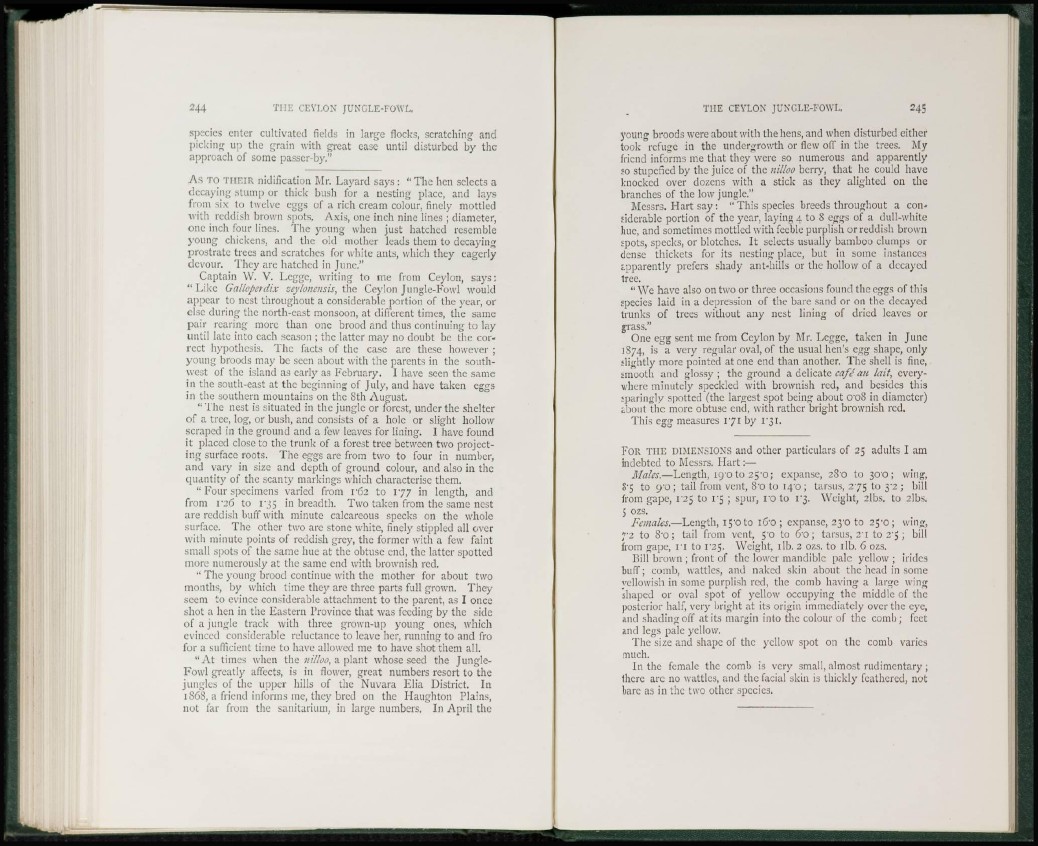
species enter cultivated fields in large flocks, scratching and
picking up the grain with great ease until disturbed by the
approach of some passer-by."
As TO THEIR nidification Mr. Layard says : " The hen selects a
decaying stump or thick bush for a nesting place, and lays
from six to twelve eggs of a rich cream colour, finely mottled
v. i'.h reddish brown spots. Axis, one inch nine lines ; diameter,
one inch four lines. The young when just hatched resemble
young chickens, and the old mother leads them to decaying
prostrate trees and scratches for white ants, which they eagerly
devour. They arc hatched in June."
Captain \V. V. Lcgge, writing to me from Ceylon, says:
" Like Galloperdix zeylonensis, tbe Ceylon Jungle-Fowl would
appear to nest throughout a considerable portion of the year, or
else during the north-cast monsoon, at different times, the same
pair rearing more than one brood and thus continuing to lay
until late into each season ; the latter may no doubt be the correct
hypothesis. The facts of the case arc these however ;
young broods may be seen about with the parents in the southwest
of the island as early as February. I have seen the same
in the south-east at the beginning of July, and have taken eggs
in the southern mountains on the Sth August.
" T h e nest is situated in the jungle or forest, under the shelter
of a tree, log, or bush, and consists of a hole or slight hollow
scraped in the ground and a few leaves for lining. I have found
it placed close to the trunk of a forest tree between two projecting
surface roots. The eggs are from two to four in number,
and vary in size and depth of ground colour, and also in the
quantity of the scanty markings which characterise them.
" Four specimens varied from rc»2 to 177 in length, and
from 1 '26 to 1 \] 5 in breadth. Two taken from the same nest
are reddish buff with minute calcareous specks on the whole
surface. The other two arc stone white, finely stippled all over
with minute points of reddish grey, the former with a few faint
small spots of the same hue at the obtuse end, the latter spotted
more numerously at the same end with brownish red.
" The young brood continue with the mother for about two
months, by which time they are three parts full grown. They
seem to evince considerable attachment to the parent, as I once
shot a hen in the Eastern Province that was feeding by the side
of a jungle track with three grown-up young ones, which
evinced considerable reluctance to leave her, running to and fro
for a sufficient time to have allowed me to have shot them all.
"At times when the nilloo, a plant whose seed the Jungle-
Fowl greatly affects, is in flower, great numbers resort to the
jungles of the upper hills of the Nuvara Elia District. In
186S, a friend informs me, they bred on the Haughton Plains,
not far from the sanitarium, in large numbers. In April the
young broods were about with the hens, and when disturbed either
took refuge in the undergrowth or flew off in the trees. My
friend informs me that they were so numerous and apparently
so stupefied by the juice of the nilloo berry, that he could have
knocked over dozens with a stick as tbey alighted on the
branches of the low jungle."
Messrs. Hart say: " This species breeds throughout a considerable
portion of the year, laying 4 to 8 eggs of a dull-white
hue, and sometimes mottled with feeble purplish or reddish brown
spots, specks, or blotches. It selects usually bamboo clumps or
dense thickets for its nesting place, but in some instances
apparently prefers shady ant-hills or the hollow of a decayed
tree.
" We have also on two or three occasions found the eggs of this
species laid in a depression of tbe bare sand or on the decayed
trunks of trees without any nest lining of dried leaves or
grass."
One egg sent me from Ceylon by Mr. Lcgge, taken in June
1S74, is a very regular oval, of the usual hen's egg shape, only
slightly more pointed at one end than another. The shell is fine,
smooth and glossy; the ground a delicate caféau /ait, everywhere
minutely speckled with brownish red, and besides this
sparingly spotted (the largest spot being about O'oS in diameter)
about the more obtuse end, with rather bright brownish red.
This egg measures 171 by I '31.
FOR THE DIMENSIONS and other particulars of 25 adults I am
indebted to Messrs. Hart :—
Males.—Length, 19/01025-0; expanse, 2S0 to 300; wing,
8'5 to 9'0 ; tail from vent, 8'0 to 140 ; tarsus, 275 to 3'2 ; bill
from gape, ¡'25 to 1-5 ; spur, i'0 to 1*3. Weight, 2lbs. to 2lbs.
5 ozs.
Females.—Length, 15'Oto I6jO ; expanse, 23^0 to 25^0 ; wing,
7"2 to 8'0 ; tail from vent, 5'0 to 6"0 ; tarsus, 2T to 2"$ ; bill
from gape, I I to 125. Weight, lib. 2 ozs. to lib. 6 ozs.
Bill brown ; front of the lower mandible pale yellow ; irides
buff; comb, wattles, and naked skin about the head in some
yellowish in some purplish red, the comb having a large wing
shaped or oval spot of yellow occupying the middle of the
posterior half, very bright at its origin immediately over the eye,
and shading off at its margin into the colour of the comb ; feet
and legs pale yellow.
The size and shape of the yellow spot on the comb varies
much.
In the female the comb is very small, almost rudimentary ;
there arc no wattles, and the facial skin is thickly feathered, not
bare as in the two other species.